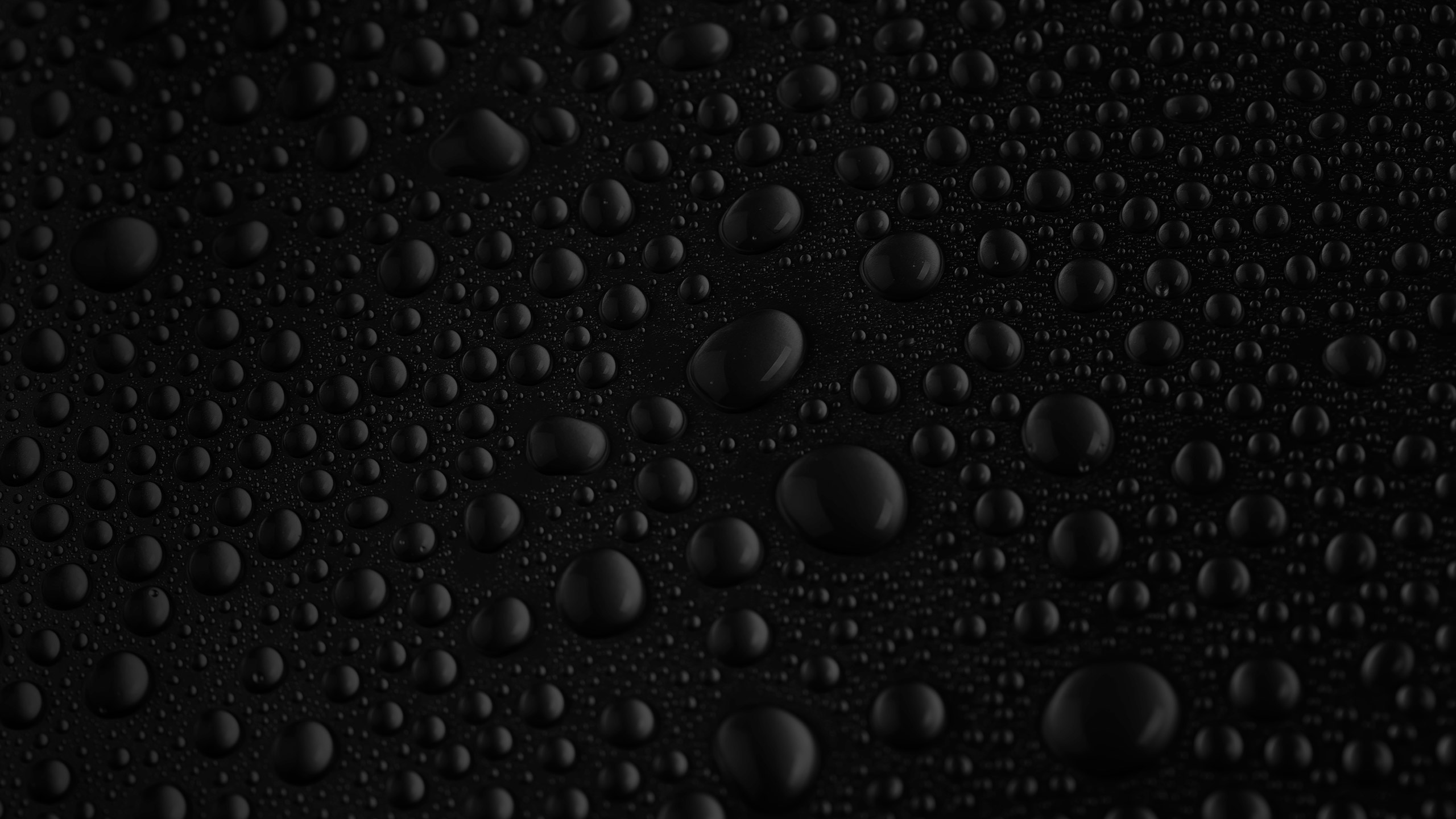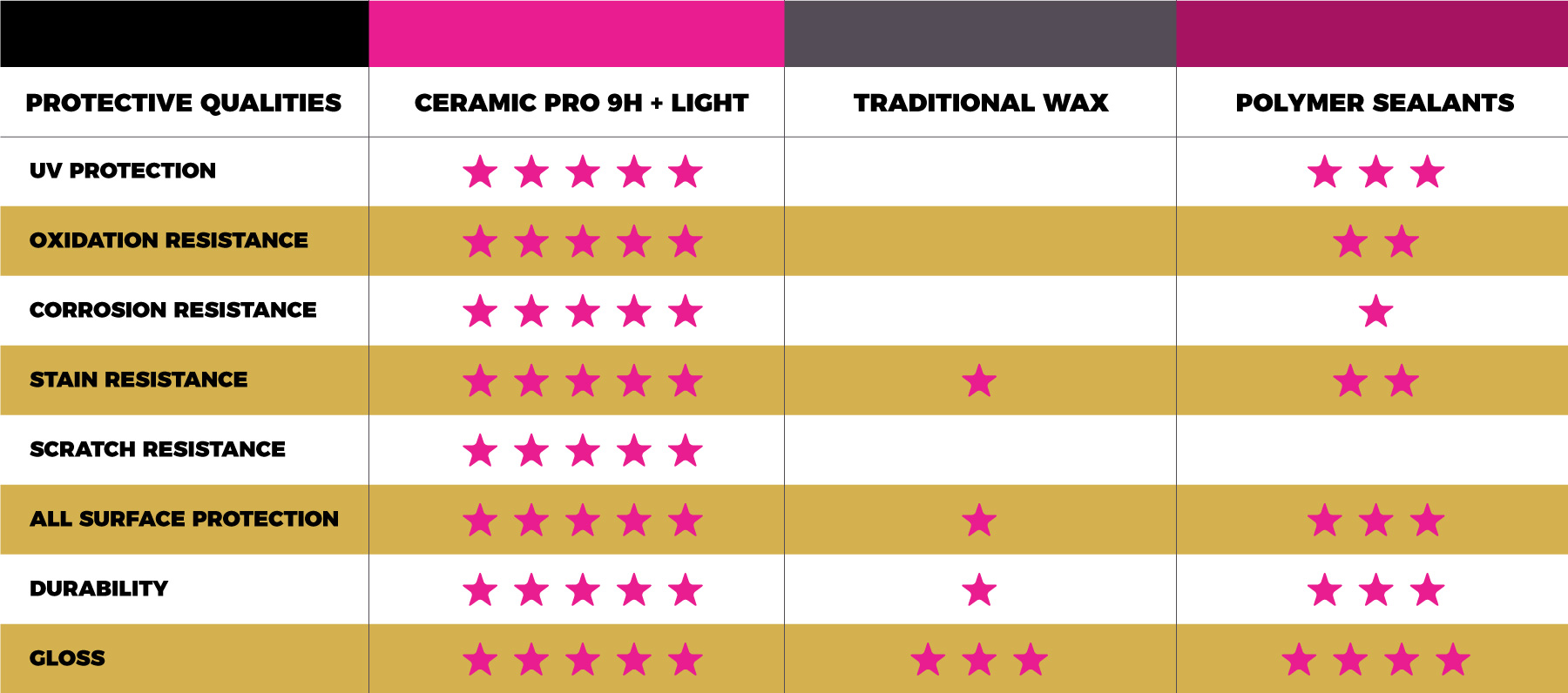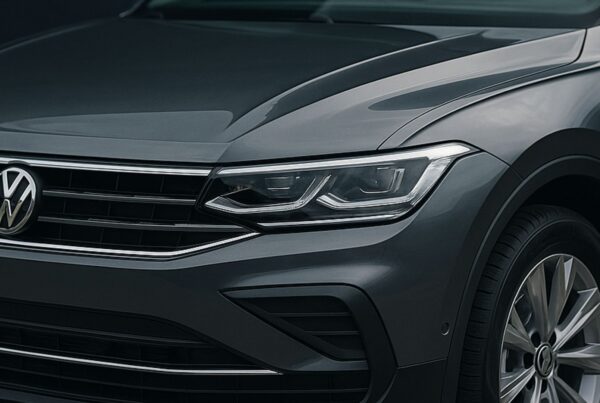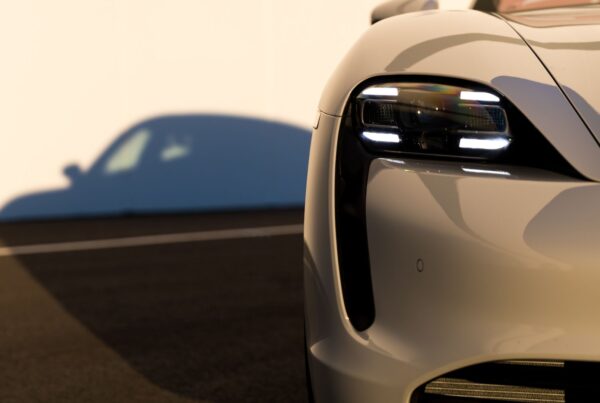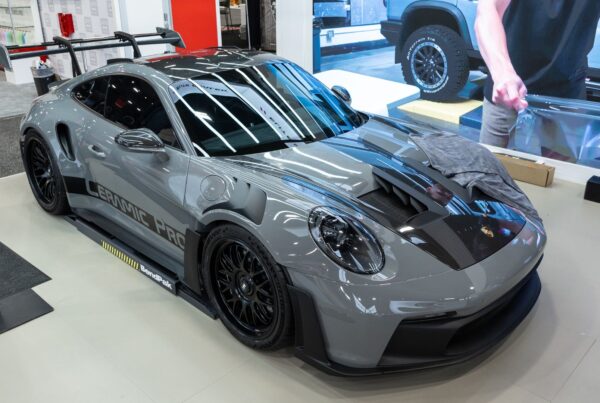The State of Ceramic Coatings in 2022
A few years ago, we wrote an awesome blog that talked about the multitude of ceramic coatings for cars. That was before the dark times – or the days when our industry was introduced to the latest marketing buzzword – Graphene Coatings. The automotive detailing industry has been slammed with the next and allegedly best ceramic coating products for 2022 – including ceramic wax and a slew of graphene-infused polymer paint sealants.
It’s gotten so intense and competitive, that many of our professional-grade ceramic coating products competitors are starting to release direct-to-consumer grade products for the DIY enthusiast – each using the latest “invention” to manipulate consumers.
In short – the ceramic coating world is becoming flooded with a slew of imitation products that are unproven – untested – and quite frankly – unacceptable. At Ceramic Pro, we’ve worked hard over the past decade to provide a superior 9H ceramic coating that is proven to last longer, protect better, and keep cars cleaner than competitors.
So, let’s discuss the state of the union for ceramic coatings for cars in 2022.
What is the Purpose of a Ceramic Coating for Cars?
On the surface of every car is primer, a base coat of paint, and a clear coat which protects the paint from external elements. A ceramic coating for cars is a product that is applied to the surface of your car on top of the clear coat.
Essentially, a ceramic car coating is a second layer of skin on the surface of your car. It utilizes nanotechnology, which are tiny particles that come together to form a very thin and transparent layer that is completely invisible to the naked eye.
This layer seals the pores on your car’s paint, producing superior hydrophobic properties, as well as more resistant to ultra-violet rays, scratches, chemicals, and extreme heat. The ceramic coat forms a semi-permanent bond with the surface of your vehicle meaning that it will not wash away or break down over a short period of time.
Learn How Affordable a Professional Ceramic Coating Can Be Get Your FREE Estimate NOW
What’s the Deal with Graphene Coatings for Cars?
The new kid on the automotive coating block is what is being marketed and sold as a graphene coating. For those not aware, graphene is technically defined as “an allotrope of carbon consisting of a single layer of atoms arranged in a two-dimensional honeycomb lattice nanostructure.”
For those that need a translation into basic English – graphene is a thin but ultra-strong substance that has been proven to be one of the strongest elements ever created. In fact, it’s 200 times stronger than steel, lighter than paper, and with extraordinary mechanical and electrical properties.
You’re probably asking – “well, is graphene bulletproof?” Actually – yes. A study at Rice University in the Great State of Texas determined that if 300 layers of graphene were combined (about 100nm nanometers in thickness) it could stop a micro bullet traveling at three kilometers per second (that’s faster than the projectile shot out of a military M-16).
How big is a nanometer. Let’s just say that your average piece of writing paper measures 100,000 nanometers thick. So – graphene is really strong.
But that’s not the raw material included in a ‘graphene coating’.
Today’s marketed ‘Graphene Coatings’ are said to contain Graphene Oxide. This substance is a byproduct or graphene which is created by way a chemical process. And – it’s also a very good conductor of electricity. In fact, if it was added to a nano ceramic coating that works by electrically bonding to a surface, in theory – it could strengthen the bond and improve performance.
But – that’s not what’s in a graphene coating either.
The real active ingredient is Reduced Graphene Oxide or rGO. This material is a reduced form of monomolecular graphene oxide sheet, which are dispersible in solvents and water (making graphene oxide and IDEAL active ingredient to enhance a ceramic coating.
RGO on the other hand is less dispersible – and does not carry the oxygen-containing functional groups that help to strengthen electrical bonds. This material is primarily used in the production of batteries, supercapacitors, biomedical applications, and printable graphene electronics.
Some of the claims of graphene coatings (which we’ve proven above is not technically accurate) includes:
- Superior protection from grime, water spots, corrosion, and an easier application process.
- Long-lasting protection – many manufacturers claiming 10+ years of longevity through a single layer of application.
- Improved car detailing time for car owners.
- Can be infused into sprayable formulas, making them better than ceramic spray coating.
While there have been many DIY or even professional detailers testing graphene coatings, at the time of this blog being published (May 20th, 2022) – there are ZERO scientific tests or documented evidence that proves that today’s ‘graphene coatings’ last longer, offer better protection, or improve car detailing time vs a high-quality ceramic coating.
So let’s just say – in 2022 the verdict is still OUT on graphene coatings. If you want buy into the hype – without proven testing or infusing common sense into the effectiveness of these products, have at it.
DIY Coatings vs Professional 9H Nano Coatings
When it comes to Ceramic Coating, you have a few options. You can have it applied professionally or you can do it yourself. Since ceramic car coating has become more mainstream, DIY consumer kits have become common and can be a viable option if you are on a tighter budget. Some are harder to install while others are simple spray and wipe off quick coat solutions.
Professional Application
The professional ceramic coating cost from Ceramic Pro starts at just $300 depending on the package that is best for you. These ceramic coatings are applied by trained and certified professionals. The process typically takes anywhere between 1-5 days depending on the original condition of your paint.
DIY Application
Recently, consumer level car coatings have been entering the marketplace making it more accessible to drivers who are more concerned about protection against the elements and ease of cleaning. These products are specially formulated, making them less sensitive than professional-grade car coatings and can be applied with little to no experience.
However, the quality and durability can vary based on the product. It is important to note that the DIY segment of ceramic coating is packed with inferior products with over-exaggerated claims.
In 2022 – the main dispute between DIY ceramic coating manufacturers is the battle for who has the most silica or SiO2 in their formulation. The problem is – when you add a higher percentage of SiO2, you need a corresponding increase of carrier solvents for the coating to harden – which creates extended longevity and flatness of the coating.
Since DIY coatings remove most carriers solvents from their formulations – to make it easier for consumers to install, it’s a waste of raw ingredient. The moral of the story – if you’re looking for the best car coatings for DIY enthusiasts, don’t buy into the highest percentage of SiO2 available marketing hype. They do not last if professionally applied Ceramic Pro products.
Pros
- Nano ceramics are relatively user-friendly and easier to apply
- Ceramic coating a car offers extremely cost-effective paint protection
- The results are visible, but have a lot of variables that factor into the quality
Cons
- Properly preparing the surface of your paint can be difficult
- You may need to conduct extensive research because there are a lot of poor-quality knockoffs out there
- Companies may not provide you with proper guidance in terms of application
- Some companies can exaggerate benefits
Is a Ceramic Coating Good for Cars?
Yes, a ceramic coat is good for your car. With paint correction completed prior to application, it can improve the shine of the vehicle’s paint, block UV rays, and provide a protective coating that can last years.
The idea of a ceramic paint coating is to protect your car from as much wear and tear caused by daily use as best as you possibly can. A ceramic paint application not only exceeds protection of a paint sealant, but swirl marks can be removed with paint correction, and produce an amazing shine.
When it comes to paint protection, a ceramic coat can reduce brake dust from sticking, lasts longer than wax, and improves the car’s finish. A nano coating provides a protective layer over the car’s surface and delivers the ultimate UV protection.
The surface of your car paint is constantly being attacked by tint of sunlight, and the unpredictability of nature. Bird droppings, bug splatters, and tree sap can stick, requiring a clay bar treatment when you only use car wax for protection.

Here is where a ceramic coat comes into play. An auto ceramic coating uses nanotechnology to serve as a paint coating on acid. A 9H ceramic coating like Ceramic Pro can layer on top of each coating. However, a DIY ceramic coating is not formulated for this unique attribute. As such, they don’t last exceptionally long.
These products are often referred to as a quartz coating because the main ingredient, silicon dioxide or SiO2 will harden as strong as quartz. Once cured, the coating will bond to the car’s exterior, providing a sacrificial layer of protection, repelling dirt, reducing swirl marks from occurring, and reduces oxidation.
Those swirl marks that you usually see on darker colored cars are caused by improper washing and drying techniques used when your car has a layer of dust on the surface. Ceramic coating also protects your paint from UV damage keeping the paint color looking vibrant.
What Does a Coating of Ceramic do for Cars?
This type of coating is becoming popular because of its incredible capabilities. Here is what ceramic coating can do:
Ceramic Coating is Hydrophobic
Now, what does this mean? This means that the coating is extremely water repellent. You have probably been stunned by the videos of this online, as it’s usually the first demonstration of what Nano ceramic can do.
Once it’s cured, the coating causes water to bead on the surface of your car and completely slide off. The extra layer of protection prevents water, dirt, and mud from bonding to your vehicle’s paint which makes cleaning your car much easier.
An Automotive SiO2 Coating is Mud and Dirt Repellent
If you experience a lot of ice and snow where you live, Nano ceramic can do wonders for you! Snow and ice will not stick to the surface of your car because of the extra layer protection. Rain and water bead on the surface and mud will also slide off.
A Quartz or SiO2 Coating Protects from UV Damage and Oxidation
Ultraviolet rays cause paint to oxidize, which means that the chemicals in your paint have started to break down and dry out. Over time, cars that are frequently exposed to the sun will start to see the paint fade and look dull. Not only will the paint not look as vibrant, but it will eventually start to deteriorate. Nano ceramic coating provides extra protection against UV rays, which means that your paint will continue to shine.
Ceramic Coatings Improves Durability
A ceramic coating for cars bonds with the molecular structure of your cars paint. This means that it works much harder at protecting your surface than just an ordinary paint job. Plus, it lasts for years!
What does a Ceramic Coating NOT do?
Ceramic coating a car does have a lot of benefits, but it does not make your car bulletproof. Just because your car has undergone the ceramic coating treatment does not mean that you no longer need to maintain it properly. It just makes maintenance easier! Let’s break down some of the misconceptions surrounding ceramic coating.
First things first, ceramic coatings are NOT scratch proof. A lot of companies will exaggerate claims that ceramic coatings are scratch resistant, but this is not true. Ceramic coatings will provide paint protection but are NOT resistant to rock chips and major scratches.
Ceramic Coating will help against minor scratches from things like driving through brush or unexpected animals jumping against the car. The main point is that ceramic coatings for cars are not thick or flexible enough to absorb major impact.
Second, nano coatings do not make your car maintenance free. The reality is that your car will get dirty no matter what. You will still need to wash and maintain your car, but the coating will heavily cut down the amount of time you spend on it. It does reduce the need for waxing, which will end up saving you money.
Ceramic coating is not permanent. Nano ceramic coating forms a semi-permanent bond to the surface of your car so it will not wash off and you will not need to reapply it every few months. A good ceramic coating and proper application will last you a few years.
Although ceramic coating is relatively easy to apply, it isn’t necessarily that simple. Before you can even begin to apply the Nano coating, the surface of your car must be completely free from blemishes. The car needs to be washed, clayed, and buffed to make sure the surface is smooth enough for proper application.
Paint correction is highly recommended prior to applying this type of ceramic paint enhancement product.
Lastly, ceramic paint coatings will not provide gloss. If your paint is faded before you apply the car ceramic coating, your paint will still be faded after. The prep work done before application is crucial to the appearance of your vehicle. Any damage on the surface of your car will be locking under the ceramic coating if they are not removed first.
Are Ceramic Coatings Right for You?
Yes, absolutely. The upfront investment in the protection of your car will pay for itself in the long run. Of course, it won’t make your car bullet proof, but it will do a much better job at protecting your car than an ordinary wax or sealant. If you’re looking for protection against rock chips, a clear bra or paint protection film is your best option.
What does a Ceramic Coating Cost?
Ceramic coating cost can vary based on the package that fits you best. A cheap DIY coating can cost you as little as $10 on Amazon. However, you can also buy a DIY ceramic coating kit for $70 per. In the end, you truly get what you pay for with a ceramic coating.
Plus, you really don’t know how well it’s going to work with the condition of your paint. Additionally, there are several variables that impact the performance and longevity, such as weather conditions, application techniques, and prep work. In the end, you’ll likely spend more money trying to fix application mistakes, high-spot, or scratches than it’s worth.
A professional-grade 9H ceramic coating like Ceramic Pro 9H is only applied by certified detailers and auto salons. They are sold in packages based on how long you want the protection. If you’re going to trade in your car next year, there is no need for a Ceramic Pro 9H Gold Package – a Bronze package would fit this bill at an affordable price.
PPF or Ceramic Coating?
PPF or Paint Protection film is a high-quality polyurethane film that is applied to the clear coat of painted surfaces of new or used vehicles. It’s available in different appearances such as matte finish and an optically clear version. These films are highly resistant to the contaminants your vehicle will encounter on a day to day basis.
Paint Protection Film has a high resistance to impact and abrasion. PPF provides protection against rock chips, acid rain, bug splatter and more. These are things that ceramic coating does NOT do. Ceramic Pro recently launched a revolutionary product called Kavaca – which translates as Armor in Sanskrit.
The Final Verdict on Ceramic Coatings for Cars in 2022
2022 has not been the best of years. In fact, since COVID-19, I think we’d all like a redo for the past few years. But there is one thing that is true today – as it was several decades ago when natural carnauba wax was the ‘in thing. Like any other industry, you get what you pay for – which applies to nano coatings for cars.
So, when it comes down to which is the best ceramic coatings for cars in 2022 – Ceramic Pro 9H gives you the best bang for your buck. It’s sold in multiple package levels – each backed by a Carfax Verified warranty. It provides superior protection, and is applied by experts, while you sit back and relax. To learn more about the benefits of Ceramic Pro 9H and to request a free estimate, click the link below.


